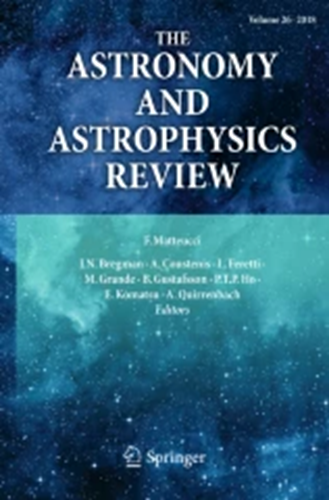TESS和SOPHIE观测到的TOI-1296b和TOI-1298b:两颗热的土星质量的系外行星,它们围绕着富含金属的恒星,密度不同
IF 26.5
1区 物理与天体物理
Q1 ASTRONOMY & ASTROPHYSICS
引用次数: 4
摘要
我们提出了两颗新的凌日系外行星候选者,由凌日系外行星测量卫星(TESS)确定为TOI-1296.01和TOI-1298.01。通过用径向速度法测量伴星的质量,SOPHIE高精度光谱仪确定了这些候选者的行星性质。这两颗行星的质量与土星相似,轨道周期也相似,都是几天。然而,它们的半径不同,因此密度也不同。这种半径上的差异可能是由主星辐照程度的不同来解释的。亚巨星TOI-1296拥有一颗密度为1.2 RJup的低密度行星,而亮度较低、体积较小的恒星TOI-1298拥有一颗密度大得多的行星,半径为0.84 RJup,其体积密度分别为0.198和0.743 g.cm−3。此外,这两颗恒星都富含重元素,金属丰度分别为+0.44和+0.49指数。TOI-1296b的行星质量和轨道周期分别为0.298±0.039 MJup和3.9443715±5.8 10−6 d, TOI-1298b的行星质量和轨道周期分别为0.356±0.032 MJup和4.537164±1.2 10−5 d。质量测量的相对精度优于13%。本文章由计算机程序翻译,如有差异,请以英文原文为准。
TOI-1296b and TOI-1298b observed with TESS and SOPHIE: Two hot Saturn-mass exoplanets with different densities around metal-rich stars
We present the discovery of two new transiting extrasolar planet candidates identified as TOI-1296.01 and TOI-1298.01 by the Transiting Exoplanet Survey Satellite (TESS). The planetary nature of these candidates has been secured with the SOPHIE high-precision spectrograph through the measurement of the companion’s mass with the radial velocity method. Both planets are similar to Saturn in mass and have similar orbital periods of a few days. They, however, show discrepant radii and therefore different densities. The radius discrepancy might be explained by the different levels of irradiation by the host stars. The subgiant star TOI-1296 hosts a low-density planet with 1.2 RJup while the less luminous, lower-size star TOI-1298 hosts a much denser planet with a 0.84 RJup radius, resulting in bulk densities of 0.198 and 0.743 g.cm−3, respectively. In addition, both stars are strongly enriched in heavy elements, having metallicities of +0.44 and +0.49 dex, respectively. The planet masses and orbital periods are 0.298± 0.039 MJup and 3.9443715± 5.8 10−6 days for TOI-1296b, and 0.356± 0.032 MJup and 4.537164± 1.2 10−5 days for TOI-1298b. The mass measurements have a relative precision of better than 13%.
求助全文
通过发布文献求助,成功后即可免费获取论文全文。
去求助
来源期刊

The Astronomy and Astrophysics Review
地学天文-天文与天体物理
CiteScore
45.00
自引率
0.80%
发文量
7
期刊介绍:
The Astronomy and Astrophysics Review is a journal that covers all areas of astronomy and astrophysics. It includes subjects related to other fields such as laboratory or particle physics, cosmic ray physics, studies in the solar system, astrobiology, instrumentation, and computational and statistical methods with specific astronomical applications. The frequency of review articles depends on the level of activity in different areas. The journal focuses on publishing review articles that are scientifically rigorous and easily comprehensible. These articles serve as a valuable resource for scientists, students, researchers, and lecturers who want to explore new or unfamiliar fields. The journal is abstracted and indexed in various databases including the Astrophysics Data System (ADS), BFI List, CNKI, CNPIEC, Current Contents/Physical, Chemical and Earth Sciences, Dimensions, EBSCO Academic Search, EI Compendex, Japanese Science and Technology, and more.
 求助内容:
求助内容: 应助结果提醒方式:
应助结果提醒方式:


